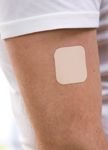Patch offers new option for early Parkinson's
FDA has approved Neupro patch designed to treat symptoms of early Parkinson's disease. Consistent and continuous drug delivery over a 24-hour period may prove to be an advantage of this patch.

"Rotigotine is a nonergoline D3/ D2/D1 dopamine receptor agonist," said Jacci Bainbridge, Pharm.D., associate professor of clinical pharmacy at the University of Colorado at Denver and Health Sciences Center. "It has demonstrated α-2 antagonistic properties, which modulate dopamine neurotransmission in the brain, and 5-HT1A agonistic activity that may provide some antianxiety effect-similar to buspirone activity."
According to the manufacturer, the efficacy of rotigotine was demonstrated in three randomized, controlled studies in 1,154 patients with early-stage PD. The patients were not receiving concomitant dopamine agonist therapy and were either l-dopa (levodopa)-naive or off l-dopa for at least 28 days prior to baseline testing, and were never taking l-dopa for more than six months. Study patients also taking selegiline, anticholinergics, or amantadine must have been on a stable dose for at least 28 days prior to study initiation.
What's different about this product, according to Bainbridge, is its potential to improve adherence to therapy because of its unique delivery and once-a-day dosing. "Rotigotine has a low oral bioavailability so a transdermal patch is useful since it bypasses first-pass metabolism," she explained. The transdermal system will also provide more consistent serum levels of rotigotine, which should, in theory, help alleviate the nausea and dyskinesias that are associated with high peaks, along with tremor and rigidity associated with low serum troughs, she said. "Commonly this is seen with pulsatile stimulation of dopamine receptors and as a result of short-acting dopamine agonists given orally."
Therapy with rotigotine should begin with the 2 mg/24 hours strength and, based on the individual patient's clinical response, the dosage may be increased weekly by 2 mg/24 hours if necessary and well tolerated. The lowest effective dose in clinical trials was 4 mg/24 hours and dosages above 6 mg/24 hours did not show any additional therapeutic effect, according to the manufacturer. Dosages above 6 mg/24 hours were also associated with an increased incidence of adverse reactions.
"By using the patch delivery system, the risk of augmentation and rebound effects may be decreased" as compared with orally available alternatives, Bainbridge noted. In addition, she explained, the unique delivery system may help benefit some patients who have difficulty swallowing oral drugs. "The transdermal route will also bypass problems associated with gastrointestinal motility and gastric emptying," she said.
In clinical trials, adverse events occurring in 5% or more of patients included nausea, vomiting, headache, dizziness, somnolence, insomnia, extremity edema, fatigue, constipation, and back pain. Many side effects appeared to be dose-related, with the highest incidence occurring with the 6 mg/24 hours system.
No dosage adjustment is necessary for patients with moderate hepatic impairment or mild to severe impairment of renal function.
TIPS TO REMEMBER Neupro